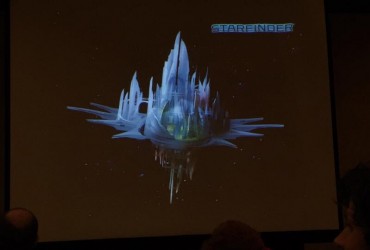Welcome back to Prep With Me, a series where I invite readers into my little prep corner and talk about the ideas I have for upcoming games and things I’m doing to make my life as a GM easier down the road. Last time, we lay the foundations for Anatolia, the City Between Worlds as a setting for a skirmish-type wargame campaign I’m running for a group of friends. When we’d last left off, I’d just finished up sketching out the broad strokes and challenges with designing a campaign of this type. Today I’d like to focus in a bit more and address the overarching plot piece that will (hopefully) drive the narrative of this game.
So, let’s start with a few core assumptions off of which we will structure our narrative. Note that because each player is leading a band of individual warriors rather than a single character I’ll be referring to them all as warbands. One need only substitute out “warbands” for “adventurers” or “PCs” and the design logic holds.
So there’s this big thing in the center of the city. A ziggurat that’s surrounded by an occlusion field that makes entry – magical or mundane – impossible. The first assumption is that warbands will divided into one of two groups regarding the ziggurat.
Group #1: Look! A shiny thing! I want it!
This isn’t too far off from a classic adventure trope. Go unlock the vault/unseal the crypt/open the portal so that you can go get the thing. It’s a generic enough hook that most warbands shouldn’t have too much difficulty come up with a reason for pursuing it. These your typical loot ‘n scoot adventurers, powermongers, or other treasure seekers.
Group #2: Look! A shiny thing! I don’t want it but you can’t have it either!
This is the necessary loophole for those warbands that just don’t want to play along as a Group #1 member. Actually having a warband with a goal contrary to the assumed default adds some nice tension to the mix. Maybe these are ancient guardians of the secret thing. Or perhaps they belong to a sect that believes the thing is best if kept hidden from the world.
Whatever the case, the primary draw for this campaign is the mystery of what’s inside the ziggurat. I know they mystery. And in a moment you will too. But for my players, figuring it will become the focal point of the narrative. I mean, there’s lots of other things that will keep my players interested in the game. Tactical combat between warbands, post-battle levelling, finding or buying new equipment. You know, the usual RPG-type stuff. But the goal is to have some exposition occur every few battles as dictated by the clues that the players uncover.
For this we return to the story of Malakai Etribiates and Astygages the Black from our last discussion because their conflict sets the groundwork for the events of present day. So Let’s flesh out a bit of that shall we? Once again, we’re spitballing ideas around. As we go, notice that I’m dropping proper nouns left and right. This will be helpful to me later as Future Me goes back and further expands on what Past Me was trying to do.
So here we go! Let’s deal with Etribiates first. We’ve established that Anatolia is a magocracy, that is to say a city ruled by those that can command magic. Etribiates is of common stock so his formal education in the arcane is rudimentary at best. However his talent and ambition eventually drive him into the upper echelons of Anatolian society. Along the way he gains the support of the Triune – the three Colleges of Anatolian magic – as well as the Charon – the city guard. Etribiates eventually attains the title of Grand Vizier, leader of the council and second only to the reigning king, Theonid Akanes. Etribiates learns that Akanes is attempting a forbidden ritual that supposedly grants the aging king immortality at the cost of city-wide devastation. The ritual would turn Akanes into a demi-god but would require the sacrifice of a huge proportion of Anatolian citizenry. With the help of representatives of the Triune and Charon, Etribiates seals the partially transformed Akanes away in a tomb inside the Great Ziggurat in the center of the city. This tomb is locked using four relics, each a symbol of office for each of the three Colleges of the Triune as well as that of the Charon. Etribiates is hailed as a hero and ascends to the now vacant Anatolian throne.
Enter Astygages the Black, one-time student of the now imprisoned King Akanes. I’m mostly envisioning Astygages as your classic black-hat ne’er-do-well. He seeks to free his master, not out of any sense of loyalty, but rather to steal his power. Astygages knows that any attempt to secure the relics away from the Triune or Charon leadership would immediately raise flags. So instead he tries a work around. He creates an elaborate system of runes that resonate at varying arcane frequencies. When combined together in certain patterns, the runes can mimic the auras of specific powerful relics. Those relics, surprise-surprise, are the same ones used to unlock Akanes tomb.
Astygages works secretly and efficiently. He gathers and subverts members of the Triune and Charon. And his coup is not uncovered by Etribiates until it is nearly too late. Realizing that Astygages is nearing the Ziggurat and that a very vengeful Akanes is soon to be released unto the world, Etribiates weaves a terrible spell that traps Anatolia in a bubble outside of temporal reality. There he hopes that he might find enough time to research a way to stop Akane and Astygages. It partially works. The temporal shift is enough to disrupt Astygages’ ritual and Akane remains trapped. With his plan foiled, Astygages and his followers escalate into all out civil war. Etribiates is one of the first casualties but before his death he manages to secret away the four relics that seal Akanes’ tomb. Astygages too is eventually killed by one of his own followers and his faction destroys itself with infighting. The remaining Anatolians waste away over the centuries, sustaining themselves physically through magic but totally out of touch with the outside world and eventually succumbing to stupor and madness.
Jump forward to present day and a crisis event somewhere else in the world (the nature of which can be up to you, I’m thinking a meteor falling) triggers a chain reaction that pops Anatolia’s temporal stasis bubble and the city flows back into reality as we know it. Given that Anatolia was once situated along a popular trade route (an analog to the real world Silk Road) it doesn’t take long for local powers to take notice. A tide of adventurers and fortune-hunters flood into Anatolia hoping to delve its riches and mysteries and a number of shanty-towns are erected on the outskirts of the city to support this fledging industry. And here’s where the players come in.
The protective field is still present around Akanes’ tomb. And while no one living knows what it protects, even those not normally sensitive to arcane phenomena can feel its power. The campaign’s narrative, therefore, is a race to be the first to open the tomb. Whether Akanes is still alive and waiting to be released or if his tomb is devoid of life and waiting to be plundered is a story for another time.
Meanwhile I’m trying to translate the keys and runes warding Akanes tomb into an actual mechanical puzzle for my players to solve. The result of that will be the subject of the next Prep With Me.






